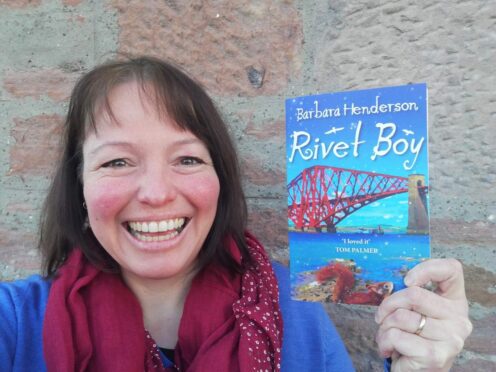A new children’s book tells the story of the role a Fife boy played in building the Forth Bridge.
Rivet Boy blends fact with fiction to tell the story of a 12-year-old boy from Dunfermline who worked on the Forth Bridge during its construction, which began in 1882.
The fictional tale, published this month, is based on a real-life account of a young boy called John Nicol who did actually work on the bridge.
Author Barbara Henderson’s research found John fell from the bridge but miraculously survived and “sustained no more than a wetting”.
Based on a real account of a Fife boy
The award-winning author used real-life details of John Nicol’s family in the story.
Barbara, 51, who was born in Germany, first visited the Forth Bridge as a child with her family and later, after coming to Edinburgh to study, had her wedding reception beneath it.
Her connection with the iconic structure inspired her to look at it as a subject for her next children’s book.
She said: “I bought a book of Scotland in Victorian times and there was a whole chapter devoted to the rising structure of the Forth Bridge.
“The questions then started kicking in and I was asking myself – what if a boy had to work on this structure despite the fact that he would much rather stay on at school.”
Who was Fife boy John Nicol?
Barbara, who lives in Inverness and works as a drama teacher, discovered an article relating to a ‘John Nicol’.
She said: “The article said he fell from the bridge and survived.
“It said he had sustained ‘no more than a wetting’.
“So I thought for a children’s book you are mine! You will be my hero.”
With the help of local researchers, Barbara dug a bit deeper and found out that the boy’s father had died before he was born.
The mum-of-three explained: “He was raised by a single mother – his father was killed in an industrial accident in Australia.
“It is very conceivable that when the boy turned 12 and was old enough to become a breadwinner in Victorian times, he would be forced to leave school to find work.”
Working on the Forth Bridge
At that time most of the jobs available involved working on the Forth Bridge and the most likely job for a boy his age was that of a rivet heater in a rivet gang.
Barbara said: “He would take the rivet, heat it in a little stove and throw it to the rivet catcher.
“They would then insert it into the pre-drilled holes,” she explained.
“One of them would hold it from the side that already had the head on it, while the others would bash in this red-hot rivet until it was in tight.
“They would then repeat this six million times to build the bridge.”
In the book Barbara wanted to introduce a counter balance to the very noisy, scary atmosphere of working on the Forth Bridge.
Carnegie Library
So she brought Carnegie Library in Dunfermline into the tale.
“I felt it was important for him to have this quiet place at Carnegie Library, which had only been open for a few years at that time.
“It is full of stories, imagination and knowledge – all the things that he was missing from school,” she said.
Forth Bridge writer-in-residence
Barbara actually has another interesting connection to the main feature in her story – the Forth Bridge.
She was named as the structure’s inaugural writer-in-residence last September by The Forth Bridge World Heritage Management Group.
The role involves writing blogs, running workshops in schools and writing about people connected to the bridge.
Barbara, who has written eight children’s books, is looking forward to ‘Rivet Boy’ being published on February 16.
She added: “It was exciting just to throw a young boy into this adventure.
“And because we don’t know all that much about him, I am inventing the ending for this.
“He probably had a more boring life than I have given him – but that is the nature of historical fiction.”
‘Rivet Boy’ will be available to buy on Amazon.












Conversation